|
.
Molybdenite Mineral Facts:
Chemical Formula: Mo2S;
60% Molybdenum by weight.
Colors:
Mineral is lead gray
Streak greenish black. In very thin flakes the mineral is translucent
with a green tinge. Otherwise it is opaque.
Hardness:
1.0
Very soft,
easily scratched by finger-nail. So soft that it leaves a black mark
when drawn across paper.
Greasy feel - used as a lubricant.
Density:
4.75
Cleavage:
Perfect basal
cleavage. It is also easily sectile, and can be cut with a knife like lead.
Crystallography: Hexagonal
Crystals in hexagonal-shaped plates or short, slightly tapering prisms.
Commonly foliated massive or in scales.
Luster:.
Metallic luster. Easily
sectile, and can be cut with a knife like lead.
Laminae flexible but not
elastic.
Optics:
(Refractive Index): Opaque
|
 |
|
Composition,
Structure and Associated Minerals:
This
mineral, which is the sulfide of the rare metal molybdenum,does not occur in
large quantity, but it is so widely distributed that it seems to be quite
abundant. It occurs principally in black scales scattered through
coarse-grained, crystalline, siliceous rocks and granular limestones and in
black or lead-gray foliated masses.
Identification and Diagnostics
By
its color, luster and
softness molybdenite is easily distinguished from all minerals but graphite.
Resembles
graphite but is distinguished from it by having a higher density, a blue
tone to color, while graphite has a brown tinge, and by its reactions for
sulfur and molybdenum.
Moreover, a characteristic test for all
molybdenum compounds is the dark blue coating produced on porcelain when the
pulverized substance is moistened with concentrated sulfuric acid and then
heated until almost dry. Before this test can be applied to molybdenite, the
mineral must first be powdered and then oxidized by roasting in the air for
a few minutes or by boiling to dryness with a few drops of
HNO3.
In the blowpipe flame molybdenite
is infusible. It, however, imparts to the edges of the flame a yellowish
green color. Naturally, it yields all the reactions for sulphur, and in the
open tube it deposits a pale yellow crystalline sublimate of MoO3.
Molybdenite is decomposed by nitric acid with the production of a gray
powder (MoO3).
Occurrence,
Localities and Origins:
Molybdenite
generally occurs embedded as grains in limestone and in the crystalline
silicate rocks, as, high temperature vein deposits in granite and gneiss, and as masses in
quartz veins, at Arendal, Norway; with the tin ores of Bohemia, china,
Mexico and New South Wales, Australia.
Found in the US
at Blue Hill Bay, Maine; at
Haddam, Conn.; in Renfrew Co., Ontario, and at
many
points in
the far western states, including the Hall mine just north of Tonopah Nevada
and Okanogan County, Washington. It is thought to be of hydrothermal origin,
where it is disseminated through the rock in porphyry deposits. It is
produced as a by-product from some copper porphyry deposits as at Bingham
Canyon in Utah. In the large deposit at Climax, Colorado it has been mined
from
quartz veinlets in silicified granite associated with topaz and
fluorite. Also found in some contact metamorphic deposits.
Use: It is
the only commercially
important ore of molybdenum. Molybdenum metal is used as an alloy f or
steel hardening. Artificial molybdenite is used in grease as a lubricant.
Return to the
Mineral Collectors Information Page |
|



